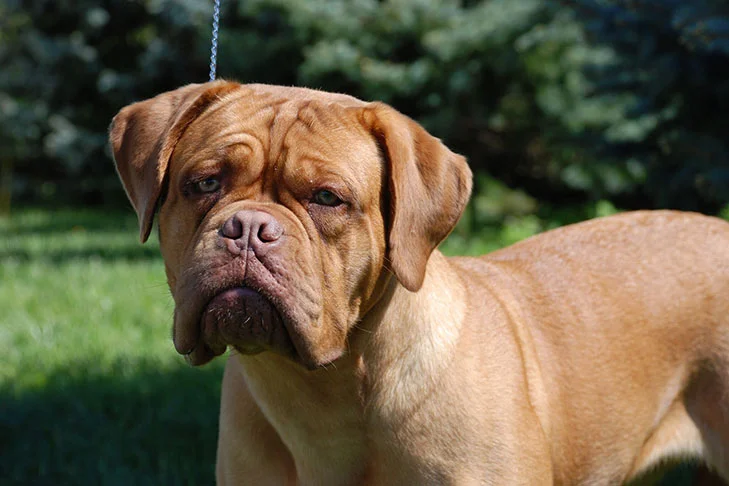The Dogue de Bordeaux, sometimes known as the “Mastiff of Bordeaux,” is the oldest of the French dog breeds and existed before France was even a country. These strong, fawn-coated guardians with great courage are renowned for being devoted, caring, and guardians. The Dogue de Bordeaux is a very muscular guard dog resembling a mastiff. Males can weigh 110 pounds and stand 27 inches tall. The fawn coat is short and striking, with rich coloring. The enormous head has an undershot jaw akin to a Bulldog, expressive eyes, and a severely furrowed brow. It has the largest head in the canine kingdom in terms of proportion. Dogues have a stocky build and are low to the ground, but when the situation demands, they may charge like lions. DDBs with the right temperament have tender, sensitive hearts. Although DDBs are loyal to family members of all ages, owners also acknowledge that the breed can be stubborn and will dominate those who do not give them firm training when they are young. It’s important to choose a trustworthy breeder when buying a canine bodybuilder of this caliber.
Dogue de Bordeaux
loyal / courageous / affectionate
Average sizes and life
expectancy of the breed.
Height
23.27 inches (male)
23-26 inches (female)
Weight
110 pounds & up (male)
99 pounds & up (female)
Life Expectancy
5-8 years
Breed Traits & Characteristics
About the Breed

What To Expect When Caring For a Dogue de Bordeaux
Owning a dog is not just a privilege; it’s a responsibility. They depend on us for, at minimum, food and shelter, and deserve much more. When you take a dog into your life, you need to understand the commitment that dog ownership entails.
 Health
Health
In the Dogue de Bordeaux, bloat, also known as gastric dilatation and volvulus (GDV), is a significant issue. Owners should educate themselves so they can spot the warning symptoms of bloat and know what to do if it does. The breed is also susceptible to heart disease, cancer, orthopedic problems (such as hips and elbows), and epilepsy. Breeders who are responsible will check their stock for illnesses that the breed may be predisposed to. Like all breeds, a Dogue de Bordeaux should have its teeth brushed frequently and have its ears checked frequently for indications of infection.
Recommended Health Tests From the National Breed Club:
- Hip Evaluation
- Shoulder Evaluation
- Elbow Evaluation
- Cardiac Exam
 Grooming
Grooming
The breed is well known for how much it drools, therefore it requires extra care at least once a week and occasionally even more frequently to keep the wrinkles on its face dry and clean. It's also crucial to clean your ears regularly and look for any signs of infection or debris. Every month, nails should be clipped. Every four to six weeks, the Dogue de Bordeaux should take a complete bath. Using a moist towel to wipe him down in between baths helps keep him smelling and looking beautiful. The breed's short coat sheds all year round, but you may minimize the amount of loose hair that ends up on the floor by using a rubber curry or shedding blade.
 Exercise
Exercise
The young Bordeaux should only engage in low-impact exercise until they are at least 18 months old to prevent stress on their developing bones and joints. They shouldn't be overworked, be permitted to run up and down stairs, or be permitted to jump off anything higher than their backs. For Bordeaux of any age, swimming is a fantastic form of exercise. An elder Bordeaux is capable of harder work, including tasks like pulling carts.
 Training
Training
Early obedience training and socialization are essential. Being a delicate breed that needs to be trusted, the Dogue de Bordeaux should not be trained harshly or with a strong hand. Ownership of the breed is not for the timid or very busy; discipline ought to be tough and constant without being harsh.
 Nutrition
Nutrition
Premium dog food was suitable for the Dogue de Bordeaux's age (puppy, adult, or senior) should be fed to the pet. Watch your dog's calorie intake and weight level because certain dogs are prone to obesity. Give table scraps infrequently, if at all, and steer clear of cooked bones and items with a lot of fat. Discover which foods fit the bill for canine consumption and which don't. If you have any worries about your dog's weight or diet, consult your veterinarian.
History
According to one idea, the Dogue is an ancient French breed that has been around for thousands of years. According to other ideas, probable distant ancestors include the Mastiff, Neapolitan Mastiff, Tibetan Mastiff, and Greek mastiff types.
According to a widely accepted origin myth, Julius Caesar’s invading troops brought the progenitors of the Dogue to France (then known as Gaul) in the first century b.c. The Romans used these enormous mastiff-like dogs as both military dogs and fearsome gladiators who engaged in combat with other dogs and wild animals in the arena. The “Bordeaux Mastiff” or “Bordeaux Bulldog,” as it was occasionally called, is believed to have existed for centuries in two different sizes. After the 1700s, the smaller variant, the Doguin, vanishes from historical records, leaving the somewhat bigger type as the modern breed known as the Dogue de Bordeaux.
Dogues have a lengthy history and have served several purposes other than fighting dogs, including guarding, drafting, and hunting. On the huge estates of the nobles by the late 1700s, they were employed as guard dogs. With the French Revolution, this job came to an abrupt end as the Dogue’s aristocratic employers were led to prison and the guillotine.
The breed managed to survive the carnage and found employment driving animals, earning the moniker “Butcher’s Dog.”
Before the debut of the comedy “Turner & Hooch” in 1989, which starred Tom Hanks as a police detective accompanied by a drooling, obstinate, but endearing Dogue, the breed was essentially unknown outside of France.


